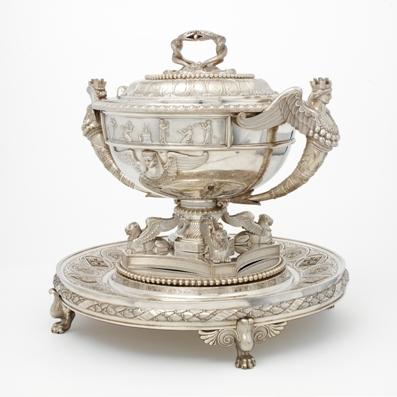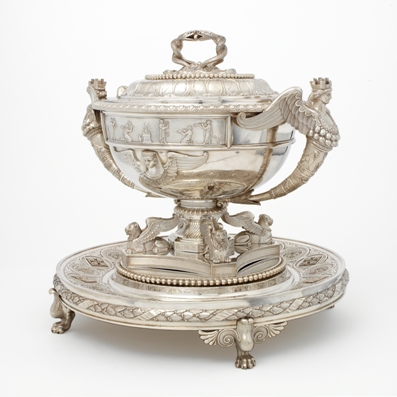
Paul Storr, Large Soup Tureen with Stand (from set of four), 1806–1807, long-term loan from the Rosalinde and Arthur Gilbert Collection on loan to the Victoria and Albert Museum, London
Bursting forth from all sides with entwined serpents, ancient fertility goddesses, and winged lions, this magnificent work by London silversmith Paul Storr vividly expresses Britain’s interest in ancient Greek, Roman, and Egyptian designs in the early nineteenth century. The tureen, one from a set of four, is part of the Gilbert Collection, now on view in the European galleries. Spurred by archaeological discoveries in Pompeii and Herculaneum, the neoclassical style gained prominence during the 1760s, combining motifs, forms, and subjects from classical Greek and Roman vocabulary. With friezes of ancient Greek figures and a winged bust in pharonic headdress, the soup tureen boasts an outstanding eclectic amalgamation of classical ornamentation and Egyptian motifs that flourished following Napoleon Bonaparte’s Egyptian campaign from 1798 to 1801.
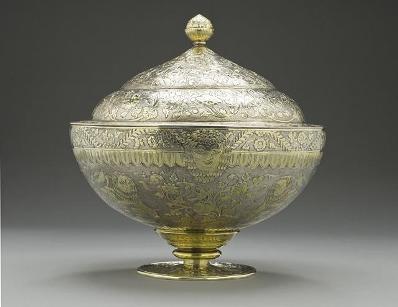
Tureen with Cover, and detail, India, Uttar Pradesh, Lucknow, c. 1775, collection of Julian Sands
Ornament and decoration were not the only things shared between cultures. Here is another soup tureen, yet this one was made in India. Part of the current exhibition India's Fabled City: The Art of Courtly Lucknow (closing this weekend), this intricately chased and engraved vessel reflects a fluid exchange of stylistic elements between Indians and the many Europeans who lived in the region during the late eighteenth century.
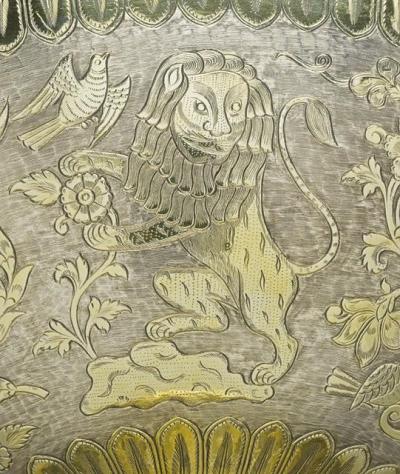
Detail
While Lucknow’s rulers adopted Western architecture and collected European decorative arts, European visitors were known to emulate Indian nobility in dress and manners. In the exhibition’s accompanying book, curator Stephen Markel notes that the soup tureen’s heraldic lions relate to European iconography and that the profuse floral decorations interspersed with birds and berries reflect a mature Lucknow style that developed from the more staid and formal floral arrangements of earlier Mughal design.
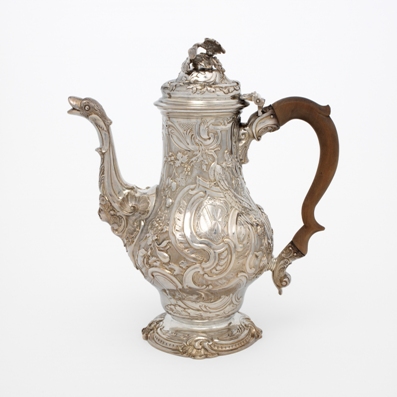
Samuel Courtauld I, Chocolate Pot, 1750–51, long-term loan from the Rosalinde and Arthur Gilbert Collection on loan to the Victoria and Albert Museum, London
Similarly, in the mid-eighteenth century, European aesthetics shifted from the stately Baroque to the fluidity and exuberance of the Rococo style, as seen in the Samuel Courtauld Chocolate Pot from the Gilbert Collection. In British silver, the Rococo style was often combined with Chinoiserie, a term derived from the French word chinois (Chinese), denoting a type of European art influenced by Asian styles. Eighteenth-century Britain was abuzz with exotic goods from all corners of the world; accessibility was due to European control of the seas and a robust import business. The unusual and, to European eyes, alien designs issuing forth from the East were a constant source of fascination. As the mania for imported Asian objects grew in the seventeenth and eighteenth centuries, Westerners began to copy and adapt Asian motifs and forms to their decorative arts. Tea caddies, coffeepots, chocolate pots, and other objects teemed with chinoiserie decorations, indulging the imbiber with scenes of the exotic locales from whence the beverages were imported. Here, the chocolate pot is decorated with undulating Rococo scrollwork and an asymmetrical cartouche, surrounded by exotic fruits and crowned with a peacock.
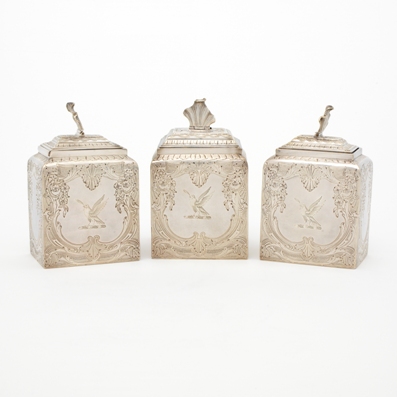
Peter Archambo, Pair of Tea Caddies and Sugar Box, 1747–48, long-term loan from the Rosalinde and Arthur Gilbert Collection on loan to the Victoria and Albert Museum, London
The introduction of coffee, tea, and chocolate to Europe during the 1650s may have had the greatest influence on both the type and style of silver produced for serving the triumvirate of caffeinated beverages. Before 1700, few Europeans had experienced drinking coffee because of an Arab monopoly that kept prices high. This changed as the Dutch East India Company transported coffee plants to the Indonesian islands, including Java, increasing production and ultimately the spread of coffee as a cash crop. The first coffeehouse in London debuted in 1652; by 1700 there were 2,000 coffee establishments in the city. The interest in tea was no less evident: By 1720, the East India Company had shipped nine million pounds of tea, and by 1750 the export of tea to the West had reached thirty-seven million pounds.
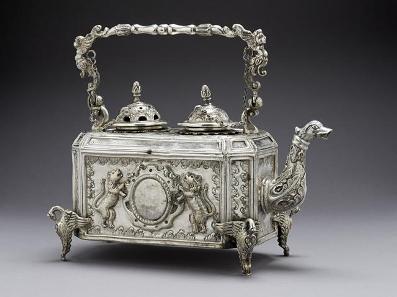
Water Heater, Bolivia, 18th century, Colección Patricia Phelps de Cisneros, Caracas
Elaborately wrought vessels for caffeinated beverages were also made in Latin America during the eighteenth century, such as this water heater for yerba maté tea, part of the Cisneros Collection currently on view in the Latin American galleries. In the same vein as the Indian soup tureen, the water heater reflects eighteenth-century Spanish American style, combining indigenous and European styles—notice the rampant lions flanking an oval cartouche. A final crucial link between the Americas and British silver is the discovery of rich silver deposits, especially in Mexico, Bolivia and Peru, which not only supplied local silversmiths, but were also exported to Europe in great quantities beginning in the sixteenth century.
Elizabeth A. Williams, Marilyn B. and Calvin B. Gross Assistant Curator, Decorative Arts and Design



